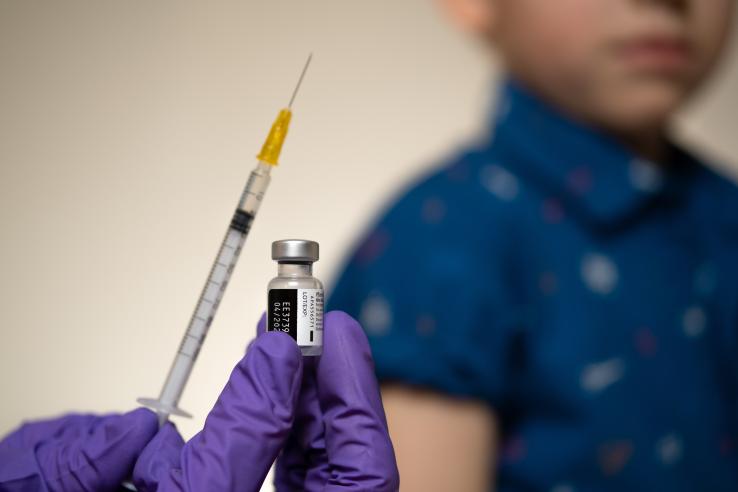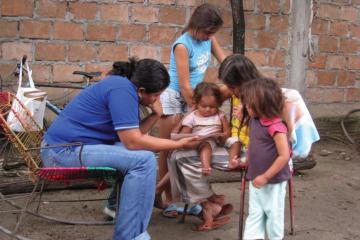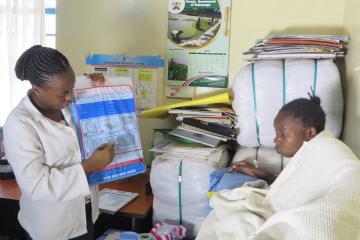
Increasing routine child immunization coverage in low- and middle-income countries

Resumen
Immunization coverage has plateaued over the last decade,1 hovering at 81 percent of infants receiving three doses of the diphtheria-tetanus-pertussis (DTP3) vaccine in 2021.2 The Covid-19 pandemic fueled the largest backslide in vaccination coverage in three decades between 2019 and 2021.3 As vaccines are one of the most impactful and cost-effective public health strategies, improving immunization coverage is key. With about 20 percent of infants not having received three doses of the DTP3 vaccine4—let alone completed the full immunization schedule—it is critical to identify interventions that help all children obtain the full immunization sequence.5
A review of 14 randomized evaluations from nine low- and middle-income countries shows that strengthening the delivery of and generating demand for immunization each play a critical role in increasing vaccination coverage. Interventions to strengthen the health system by ensuring vaccines are reliably and locally available and that health workers perform well are paramount. However, even when vaccines are available at little to no cost, factors like limited or inaccurate information, lack of trust, low perceived immediate private benefits of immunization (particularly relative to the overall societal gains from herd immunity), and behavioral biases among caregivers may limit coverage of full vaccination for children. Well-designed information campaigns, nudges, and incentives have addressed these barriers and increased demand for immunizations.

Lecciones de la Evidencia
Reliable, locally available services are a necessary precondition to improving vaccine coverage. Reducing physical distance to immunization services is an important first step, particularly in areas where vaccination is not locally available and travel costs are high. In rural Rajasthan, India, an NGO’s provision of monthly immunization camps at the village level tripled rates of full immunization, from 6 percent via the local primary health clinics to 18 percent via the camps. The immunization camps were regular and were accompanied by education from a social worker, whereas the public health system at the time was plagued with frequent health worker absenteeism. The average cost was $50.04 per fully immunized child.[2]
Community monitoring and performance-based incentives have improved health workers’ vaccine delivery performance in contexts where vaccination rates are low. In addition to locally available services, implementing interventions to improve health worker performance can be key. In Pakistan, smartphone-based monitoring alongside performance-based incentives (1,000 rupees, or approximately US$10 at the time of the study, for attempting 300 vaccinations across two days) increased the number of polio immunizations community health workers administered. Measuring health workers’ tendency to put off effort and then tailoring incentives to help them overcome this tendency was especially impactful.[1] In Uganda, a community monitoring program reduced absenteeism, the frequency of drug stockouts, and waiting times. Coverage of required vaccines increased by 1.86 percentage points among three- year-old children, and the monitoring program as a whole cost about $300 per death averted among children under the age of five years.[6] At the time, 66 percent of children in Uganda were fully vaccinated.6
However, interventions to increase provider effort were not sufficient in contexts where baseline immunization rates were higher. Another community monitoring program in Uganda had no impact on immunization once full immunization coverage across the country had improved to 85 percent.7 [13]
Additionally, interventions to increase provider effort alone have not been sufficient in contexts where the main barrier to the adoption of health services is household demand. In the Democratic Republic of Congo, paying health workers based on the number of patients seeking services such as immunization increased health workers’ attendance and efforts to attract patients. However, there was no impact on vaccination rates even though health workers sought to generate demand for services through reduced user fees and outreach. The combination of intense direct selling through preventive sessions and outreach activities, and reduced user fees, may have been interpreted as signals of lower quality health services.[9] This insight provides more details on the impact of pay-for-performance programs on health worker performance more generally.
Where the availability of vaccines is not a driving concern, information spread by effective messengers such as members of a social network can generate demand for immunization. Social networks can diffuse key logistical information such as when and where immunization services are available or the presence of incentives if they exist. Spreading messages via social networks can also increase demand by sharing information about the benefits of immunization or keeping immunization salient. A study from Haryana, India, found that well-connected individuals in a community effectively spread important information on immunization and increased full immunization coverage by 27.1 percent compared to randomly selected individuals. When randomly selected individuals in the community were tasked with spreading the information, an average of 18.1 children attended each monthly immunization camp and received at least one shot. When well-connected individuals were tasked, 23 children did so.[3]
Nudges have increased immunization rates by providing reminders that address behavioral biases such as forgetfulness. Nudges are light-touch interventions that can act as reminders to address behavioral issues such as forgetfulness and are most likely to be effective when people are not strongly opposed to vaccines. Across six studies testing the impact of reminders on vaccine completion[4] [7] [8] [10] [11] [14], five [7] [8] [10] [11] [14] found that such nudges increased vaccination timeliness, completion of the vaccination schedule, or both. In Pakistan, redesigning children’s immunization cards to be larger and simpler, with more emphasis on the child’s next scheduled vaccine, increased completion of DPT vaccinations from 39 to 66 percent. The intervention was also relatively low-cost, at $0.05 per immunization card.[14] However, in Haryana, India, personalized text and voice call reminders sent to caregivers when their child was due for an immunization had no impact, but they did have an impact in conjunction with involving local community members to verbally spread information about immunization.[4]
Incentives can increase demand and complement investments in service quality. Incentives both act as a nudge and increase the immediate perceived benefit of receiving a vaccine. Like nudges, small incentives are unlikely to overcome strong opposition to immunization but can be more effective for those who procrastinate, are ambivalent about being vaccinated, or are slightly hesitant to do so. They can also be relatively lost-cost; for instance, a program in Pakistan cost $23 per additional fully immunized child. This program also highlighted the importance of design considerations in providing incentives. Small mobile cash incentives varied in amount (caretakers received either $5 or $15 per fully immunized child), payment structure (the amount of the incentive stayed constant across all doses of the immunization schedule or increased), design (the incentives were either guaranteed or provided as lottery payments), and payment method (airtime or mobile money). Higher payments increased immunization rates more than lower payments did, and certainty in receiving the incentive was more effective than lottery payments. Additionally, providing airtime was more impactful than providing mobile money. However, there was no difference between providing payment at a constant, flat rate across doses and increasing the payments.[7]
In-kind incentives have also been effective. In the study in Rajasthan, India, mentioned earlier, providing caretakers who were bringing their children to the immunization camps with small nonmonetary incentives (a bag of lentils, a staple food, per vaccine and a set of plates upon completion of the immunization schedule) was effective in further increasing full immunization rates. The percentage of fully immunized children increased by 21 percentage points (117 percent) to 39 percent, relative to only improving the delivery of immunization. This also halved the cost of fully immunizing a child, from $50.04 per fully immunized child in camps without incentives to $25.04 in camps with incentives. The camps with incentives were busier than those without incentives, making more efficient use of the nurses’ time.[2]
In Haryana, India, offering caregivers mobile phone credit had no impact unless the credit was offered as part of a package that included word of mouth from local community members and was structured such that the amount of credit received increased over the course of the immunization schedule. This finding highlights the need to widely diffuse information about the presence of incentives.[4]
Regular cash transfers conditioned on the take-up of immunization can be another example of using incentives to generate demand for immunization. Such transfers provide income support to households in exchange for the household undertaking prespecified behaviors. However, cash transfer programs conditioned on the take-up of vaccination have not consistently shown an impact on increasing vaccination rates and in some cases increased rates for some vaccines in the vaccination schedule and not others. [5][12] This insight provides more details on the impact of cash transfers on child health more generally.
Implementing multiple interventions together may maximize impact and cost-effectiveness. Many studies test one type of intervention at a time without comparing different interventions or testing them in combination with one another. Additionally, even when interventions increase immunization rates, vaccination rates in the region often remain below target rates. Multiple interventions may need to be implemented to maximize overall effectiveness (maximizing immunizations) or cost-effectiveness (maximizing immunizations per dollar spent).
In the study from Haryana, India, researchers tested 75 unique combinations of targeted reminders, incentives, and local immunization ambassadors. The most effective package of interventions combined well-connected local immunization ambassadors, targeted SMS reminders, and small non-cash incentives (mobile phone credit) to caregivers, increasing measles vaccination by approximately 55 percent (4.02 measles vaccines per village per month). The most cost-effective policy combined local immunization ambassadors with SMS reminders without incentives: adding local ambassadors and text messages to the government’s routine immunization program increased the number of fully immunized children per dollar spent by 9.1 percent relative to the status quo because the combination was particularly effective and inexpensive.[4]
J-PAL Policy Insight. 2022. "Increasing routine child immunization coverage in low- and middle-income countries." Cambridge, MA: Abdul Latif Jameel Poverty Action Lab
GBD 2020, Release 1, Vaccine Coverage Collaborators. 2021. “Measuring Routine Childhood Vaccination Coverage in 204 Countries and Territories, 1980–2019,” The Lancet 398 (10299): P503–521.
Andreoni, James, Michael Callen, Muhammad Y. Khan, Karrar Jaffar, and Charles Sprenger. “Using Preference Estimates to Customize Incentives: An Application to Polio Vaccination Drives in Pakistan.” Working Paper, September 2019.
Banerjee, Abhijit Vinayak, Esther Duflo, Rachel Glennerster, and Dhruva Kothari. 2010. “Improving Immunisation Coverage in Rural India: Clustered Randomised Controlled Evaluation of Immunisation Campaigns with and without Incentives.” BMJ: 340.
Banerjee, Abhijit, Arun G. Chandrasekhar, Esther Duflo, and Matthew O. Jackson. 2019. “Using Gossips to Spread Information: Theory and Evidence from Two Randomized Controlled Trials.” The Review of Economic Studies 86, no. 6: 2453–2490.
Banerjee, Abhijt, Arun G. Chandrasekhar, Esther Duflo, John Floretta, Matthew O. Jackson, Harini Kannan, Francine Loza, Anirudh Sankar, and Anna Schrimpf. “Selecting the Most Effective Nudge: Evidence From a Large Scale Experiment on Immunization.” NBER Working Paper # 28726, April 2021. doi: 10.3386/w28726.
Barham, Tania and John A. Maluccio. 2009. “Eradicating Diseases: The Effect of Conditional Cash Transfers on Vaccination Coverage in Rural Nicaragua.” Journal of Health Economics 28, no. 3: 611–621.
Björkman, Martina and Jakob Svensson. 2009. “Power to the People: Evidence From a Randomized Field Experiment on Community-Based Monitoring in Uganda.” The Quarterly Journal of Economics 124, no. 2: 735–769.
Chandir, Subhash, Danya A. Siddiqi, Sara Abdullah, Esther Duflo, Aamir J. Khan, and Rachel Glennerster. 2022. “Small Mobile Conditional Cash Transfers (mCCTs) of Different Amounts, Schedules and Design to Improve Routine Childhood Immunization Coverage and Timeliness of Children Aged 0–23 Months in Pakistan: An Open Label Multi-Arm Randomized Controlled Trial.” eClinical Medicine 50: 1–14.
Gibson, Dustin, Benard Ochieng, E. Wangeci Kagucia, Joyce Were, Kyla Hayford, Lawrence H. Moulton, Orin S. Levine et al. 2017. “Mobile Phone-Delivered Reminders and Incentives To Improve Childhood Immunisation Coverage and Timeliness in Kenya (M-SIMU): A Cluster Randomised Controlled Trial.” Lancet Global Health 5, no. 4: e428–e438.
Huillery, Elise and Juliette Seban. 2021. “Financial Incentives, Efforts, and Performances in the Health Sector: Experimental Evidence from the Democratic Republic of Congo.” Economic Development and Cultural Change 69, no. 3: 1115–1164.
Ibraheem, Rasheedat, Moshood Akintola, Mohammed Abdulkadir, Hafsat Ameen, Oladimeji Bolarinwa, and Muhammed Adeboye. 2021. “Effects of Call Reminders, Short Message Services (SMS) Reminders, and SMS Immunization Facts on Childhood Routine Vaccination Timing and Completion in Ilorin, Nigeria.” African Health Sciences 21, no. 2: 951–959.
Mekonnen, Zeleke A., Kassahun A. Gelaye, Martin Were, and Binyam Tilahun. 2021. “Effect of Mobile Phone Text Message Reminders on the Completion and Timely Receipt of Routine Childhood Vaccinations: Superiority Randomized Controlled Trial in Northwest Ethiopia.” JMIR mHealth and Uhealth 9, no. 6: e27603.
Morris, Saul S., Rafael Flores, Pedro Olinto, and Juan Manuel Medina. 2004. “Monetary Incentives in Primary Health Care and Effects on Use and Coverage of Preventive Health Care Interventions in Rural Honduras: Cluster Randomised Trial.” The Lancet 364, no. 9450: 2030–2037.
Raffler, Pia, Daniel N. Posner, and Doug Parkerson. “Can Citizen Pressure Be Induced to Improve Public Service Provision?” Working Paper, March 2022.
Usman, Hussain R., Saeed Akhtar, Faiza Habib, and Imtiaz Jehan. 2009. “Redesigned Immunization Card and Center-Based Education to Reduce Childhood Immunization Dropouts in Urban Pakistan: A Randomized Controlled Trial.” Vaccine 27, no. 3: 467–472.
Related Content

Using cash transfers to improve child health in low- and middle-income countries

Encouraging early childhood stimulation from parents and caregivers to improve child development
